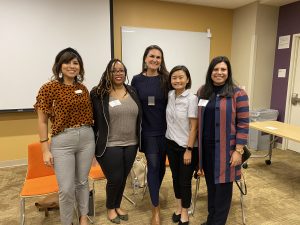On February 25th, we hosted a forum aimed at increasing understanding of how systemic racism continues to plague communities of color in the Sacramento region. We selected this topic because of its connection to so many challenges we have in the Sacramento region: serious gaps in educational outcomes, incarceration disparities, and wealth gaps. To get the conversation, we tapped the following community leaders to participate in a panel discussion:
 Dr. Viridiana Diaz, Assistant Vice President of Strategic Diversity Initiatives at Sacramento State
Dr. Viridiana Diaz, Assistant Vice President of Strategic Diversity Initiatives at Sacramento State
Jetaun Stevens, President of Greater Sac Urban League Young Professionals, counsel at the Children’s Law Center
Britta Guerrero, CEO, Sacramento Native American Health Center
Nancy Xiong , Development and Communications Director, Hmong Innovating Politics
Discussion Highlights
We used this set of definitions to ground us in understanding different types of racism, but the conversation largely focused on challenges that regularly show up for people of color in the region as a result of structural racism. While racism is a major societal challenge, the discussion centered on the day to day experiences of our community members that are generated by institutional racism.
In her role as a resource for migrant students at Sac State, Viridiana described how many students face challenges of needing to hide undocumented status from friends and romantic partners, or experiencing immense guilt from having opportunities previously inaccessible to family members.
Nancy recounted visits to the grocery store acting as a translator for her Hmong parents from a very young age and noted the importance of translation programs to our community infrastructure. Despite this, these are services that are often cut from program budgets on local, state, and federal levels. When these programs are underfunded or absent, these communities are disconnected from basic needs like food and healthcare, and their path to success is much less straightforward than their native English speaking counterparts.
Jetaun provided context for how redlining prevented communities of color from 1-settling in ideal areas of the city that provided better access to education, healthcare, etc. 2-settling in areas that were eligible for federal housing grants and loans. When identifying current issues, she notes that for YPs of color, the biggest barrier is experience opportunities are not being presented to them so they can move up. They’re not getting the sponsors or mentors their white counterparts are getting, which is a barrier to moving up in their career.
Author’s note: At the time there were discriminatory laws in place forcing communities of color to reside in those areas, silently labeling them as areas to be avoided and not worth investing in. Fast forward to 2020, and the same areas are still underinvested in and the families residing there are only allowed to attend schools in the same area. Spoiler alert: these schools are often underfunded and have incredibly poor outcomes for students that attend them.
Britta expressed “People don’t see Indians as real people. They see us as historical, not as humans. Red face and tomahawk chops have a negative effect on a family. You wouldn’t use sombreros for Mexicans”. She also discussed how racism impacted her experience as a college student: “I was pulled over and tested 38 times in my college career because of the idea that Indian people drink a lot. I never had a drinking problem. This was incentivized racism.”
What we heard back from attendees:
We received A LOT of love and enthusiasm for this event. Thank you! We also received many comments that had wished that we would have gotten into the roots of institutional racism and also how to deal with it when racially motivated events happen in day to day life.
We hear you and sincerely appreciate the feedback.
Our forum in August will cover microaggressions and how to address them when they’re happening to you. We’ll even provide programming to empower members to address them when they’re not being directly affected.
As for the rest of the recommendations, know that we’ll lean on them for inspiration for content for the coming months.
Where do we go from here?
Step 1: Keep going. This forum was intended to be a step in a lifelong journey in understanding how historically established systems of privilege continue to impact various members of our community.
Step 2: Ask questions. These questions could be as simple as “why” and as direct as “why aren’t there any people of color, women, differently abled representation, etc.” If there’s not a physical person able to represent a specific community, are there other avenues being explored to ensure everyone’s viewpoints are considered at the table? Questions keep the dialogue alive and moving towards progress in the right direction.
Step 3: Commit to keeping your mind open and expanding your perspective. We are signaled by media, education, and sometimes everyday conversations to view certain communities as lesser. As our panelist Nancy mentioned: “you don’t even notice when you’re thinking less of yourself” at times. Creating a world in which everyone is valued and celebrated is only possible if we push ourselves to engage with different points of view.
Below are some resources provided by panelists to continue the conversation:
Metro EDGE Resources:
Add to your feed, Expand your perspective
DIversity, Inclusion, Belonging
Whether you attended this forum in person or you’re using this post to find out what you missed, we hope you gained some helpful insight on what institutional racism is and how it affects Sacramento. Be sure to look into the resources provided by the panelists and we hope to see you at our next EDGEucational forum in April!

